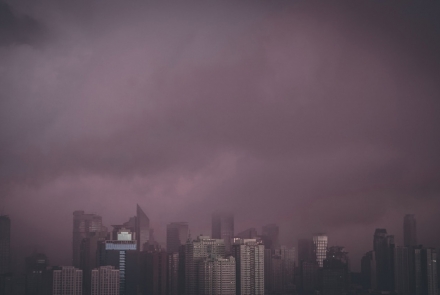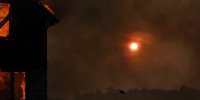
PHOTO: JC Gellidon on Unsplash
From smog to smoke to sustainable wellbeing
At the dawn of the decade in 2020, things look incredibly bleak. I sat in my apartment in Canberra, Australia on 1 January, 2020 surrounded by dense smoke from the catastrophic bushfires consuming the country’s coast and thought: this has got to finally wake people up – the entire country is burning up!
The increasing heat and drought that caused fires of this magnitude is obviously related to climate change. The majority of the population of Australia agrees, yet Australia’s Prime Minister and his party are still in denial. Sadly, it seems to take major disasters that directly affect people’s lives in order to make major changes.
For example, I was born and spent the first eight years of my life in Donora, Pennsylvania – a small steel mill town on the Monongahela River 39 kilometres southeast of Pittsburgh. Two years before I was born, Donora was the site of the first case of fatal air pollution in the US. From 27-31 of October, 1948 a temperature inversion trapped the hydrogen fluoride and sulphur dioxide emissions from US Steel’s zinc and wire works in the valley. This created an acrid smog that lasted for four days and was so thick that it looked like midnight at noon.
The incident led to 20 immediate deaths, another 50 within the following month, and continuing respiratory problems for a large fraction of the population.
My mother was six months pregnant at the time. She contracted pleurisy and pneumonia as a result of the incident and had a miscarriage.
The results of this incident were far-reaching. Lawsuits were filed against US Steel. This event, along with similar smog events in London and Los Angles, triggered the clean air movement in the US, which ultimately led to the Clean Air Act of 1970 and the establishment of the Environmental Protection Agency (EPA). Devra Davis’ book When smoke ran like water details the events leading up to the smog and its local and global repercussions.
Growing up in Donora, the event was little talked about. My mother had four sisters who all lived locally, so I was surrounded by loving aunts, uncles, and cousins. But the incident led to the eventual closing of the steel mill where my father (and a large percentage of the town) worked and we moved to Florida when I was eight years old.
But the incident certainly made an impression. It was the dawn of the ‘Great Acceleration’ and the beginning of the Anthropocene Epoch, when human impacts on our ecological life support systems were rapidly expanding in scale and scope. Rapid economic growth in the US would continue for decades, but the Donora smog, and many other incidents, clearly showed some of the negative side effects of this headlong expansion.
The creation of the EPA and other regulatory bodies in the US, and around the world, were intended to curb these side effects. But the single-minded focus on GDP growth, which started in the post-World War II years, continued. It’s unintended environmental and social side effects were rapidly increasing and more global.
Today we are battling the climate crisis caused by the continued burning of the fossil fuels that drove the post-WWII economic expansion. The consequences of this expansion are creating an unstable climate with worsening droughts, floods, storms, and fires.
Canberra is a place I thought would never look like Donora in 1948. Canberra is the seat of federal government, has no large industries, and is committed to having 100 per cent renewable electricity production by 2020.
But on New Year’s Day 2020, Canberra had the worst air pollution in the world – worse than Delhi and Dhaka – with readings at times more than ten times hazardous levels due mainly to small particles less than 2.5 micrometers contained in the smoke from the massive bush fires consuming Australia’s east coast.
Despite denial from Prime Minister Scott Morrison and his conservative colleagues, the unprecedented magnitude of these fires is related to the changes in the climate and extended drought caused mainly by burning fossil fuels.
The smog in Donora and related incidents in London and Los Angles led to rapid and concerted action on air pollution. Pittsburgh, Los Angeles, and London today have relatively clean air. That change happened largely as a result of public outcry and demand for action in the face of massive industry denial and resistance.
We are seeing the same pattern on a much more massive scale today. The fossil fuel and minerals lobby has a strangle hold on many countries. Subsidies to fossil fuels globally were estimated to top $5.2 Trillion in 2017 and fossil fuel money is pouring into disinformation, lobbying, and political campaigns around the world. This has slowed the transition to renewable solar and wind energy, even though these sources are now cheaper than fossil fuels, especially in sun-burnt Australia.
As in the 1950s and 1960s, we now need a concerted effort in order to break our fossil fuel addiction and move rapidly to a renewable energy future. This is already happening, with initiatives as diverse as Extinction Rebellion, the youth climate movement, initiatives to divest from fossil fuel companies, class action law suits against fossil fuel companies for climate damages, lawsuits against governments in the Netherlands and the US to force action on climate, and the Earth Atmospheric Trust as a way to funnel funds back into reducing emissions and sequestering carbon.
We are also seeing the rapid growth of political movements like the Green New Deal and the Wellbeing Economy, governments that espouse a net zero carbon, sustainable wellbeing agenda and lay out the policies needed to get there. The recent bushfire crisis in Australia and other climate related crises around the world are rapidly building support for these movements.
Ultimately, we need to shift our societal goals to a broader conception of sustainable wellbeing in order to finally resolve these issues and overcome our current addiction to fossil fuels and mindless GDP growth that benefits only the top 0.1 per cent.
If we can do that, we can create the kind of world we all want to leave to coming generations—a world that is killer smog and smoke free, sustainable, equitable, and prosperous. We have used environmental crises before to learn and make major changes and it can and will happen again.
Updated: 19 September 2024/Responsible Officer: Crawford Engagement/Page Contact: CAP Web Team













